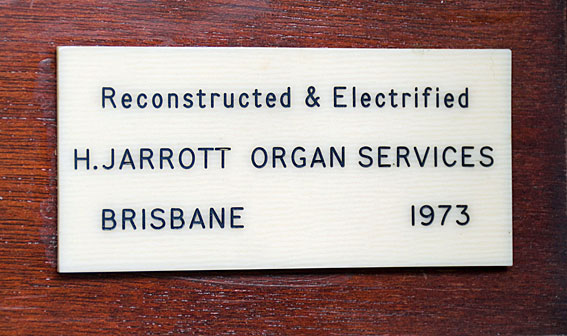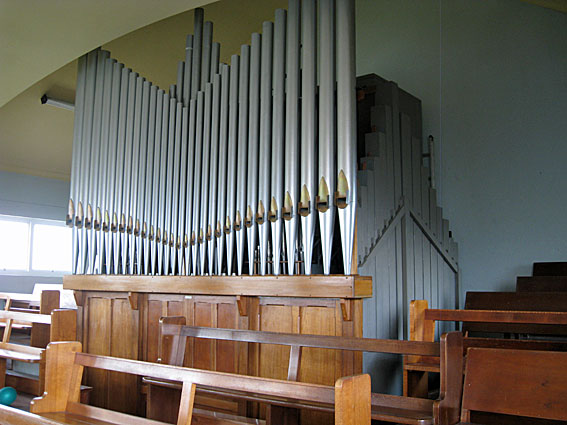
All Saints' Anglican Church, Murwillumbah
[Photograph by Trevor Bunning (November 2011)]

All Saints' Anglican Church, Murwillumbah
[Photograph by Trevor Bunning (November 2011)]
Historical and Technical Documentation by Geoffrey Cox
© OHTA 2011, 2014, 2018 (last updated February 2018)
The first recorded Anglican service was held in Murwillumbah on 26 September 1870 and regular worship commenced with the appointment of Rev'd Thomas E. Fox as the first Vicar of the Tweed and Brunswick on 23 December 1886. The district was raised to Parish status on 28 July 1901. The All Saints' congregation had worshipped at two previous sites before moving to the current location. The present All Saints' Church, designed by architects Conrad and Gargett of Brisbane, was opened and dedicated on 1 November 1960.1

The 1909 All Saints' Church and Rectory
[Photograph supplied by Ross Johnson (September 2014)]
The organ at All Saints' Church was built by Charles William Leggo of Sydney in 1926 at the cost of £1,322 for the previous (1909) wooden church on another site, where it was dedicated by the Lord Bishop of Grafton, The Right Rev. J. W. Ashton.2
The original specification of 18 stops was drawn up by the church's organist, Victor Worley, who gave the opening recital on 12 June 1926. Worley's opening recital in June 1926 included his own composition, written for the occasion, 'Romance in D'.3 One of the unusual features at the time was the inclusion of a Harmonic Bass 32ft on the Pedal. Also of note was the Great chorus complete from 16ft to 2ft.4

The Leggo organ in the 1909 church
[Photograph supplied by Ross Johnson (September 2014)]


The Leggo organ relocated to the present church
[Photographs supplied by Ross Johnson (September 2014)]

The builder's nameplate
[Photograph by Geoffrey Cox (September 2014)]
The organ was moved to the present church by H.W. Jarrott of Brisbane, when the new building was opened in 1960. Jarrott electrified the action in 1973, using direct electric action, and provided a new detached console in the gallery. At the same time, he added two Pedal stops, borrowed from the Great, and increased the number of couplers.5 The roof line of the gallery was altered to accommodate the organ, and the façade pipes were rearranged to suit the new location.6


Jarrott's 1973 detached console and nameplate
[Photographs by Rodney Ford (September 2014)]

The Leggo organ with reconfigured façade pipes
[Photograph by Geoffrey Cox (September 2014)]
A major restoration of the organ was undertaken in 1998 by W.J. Simon Pierce of Brisbane. As part of the restoration, Pierce converted Jarrott's direct electric action to electro-pneumatic action, refurbished the chests and wind supply, restored the wind pressures to the original levels, and re-leathered the bellows.7
Funded by three generous bequests from parishioners and a State Government heritage grant, Pierce added two stops to the Great in 2010, at the same time providing a second (mobile) drawstop console at floor level in the church.8

Mobile console supplied in 2010 by W.J.Simon Pierce
[Photograph by Rodney Ford(September 2014)]



Mobile console details
[Photographs by Geoffrey Cox (September 2014)]
The present specification is:
| GREAT Lieblich Bourdon Open Diapason Clarabella Dulciana Principal Harmonic Flute Twelfth Fifteenth Clarinet SWELL Violin Diapason Lieblich Gedackt Salicional Vox Celeste Gemshorn Cornopean Oboe PEDAL Harmonic Bass Bourdon Echo Bourdon Principal Bass Flute Fifteenth COUPLERS Swell Super Octave Swell Unison Off Swell Sub Octave [Swell Super to Great] [Swell Sub to Great] Great Super Octave Swell to Great Swell to Pedal Great to Pedal |
16 8 8 8 4 4 2-2/3 2 8 8 8 8 8 4 8 8 32 16 16 8 8 4 |
A B A B B |
[2010] [2010] [1973] [1973] [1973] [1973, since removed] [1973, since removed] [1973] |
Electro-pneumatic action (originally tubular-pneumatic, and subsequently direct electric)
[Swell] Tremulant
Compass: 61/30
4 pistons to the Great Organ (Gallery console)
4 pistons to the Swell Organ (Gallery console)
3 pistons to the Pedal Organ (Gallery console)
8 pistons to the Great Organ (Mobile console)
8 pistons to the Swell Organ (Mobile console)
12 general pistons (Mobile console)
Sequencer (Mobile console)
Balanced swell pedal.9
______________________________________________________________
1 http://www.anglicanchurchmurwillumbah.com - accessed November 2011
2 The Brisbane Courier (24 June 1926), p. 9.
3 Ross Johnson, 'Far North Coast Pipe Organ,' The Sydney Organ Journal, vol. 46, no. 3 (Winter 2015), pp. 30-32.
4 Graeme Rushworth, Historic Organs of New South Wales: The Instruments, Their Makers and Players 1791-1940 (Sydney: Hale & Iremonger, 1988), p. 167.
5 Specification and date noted by David Kinsela, as supplied January 1977 for John Maidment, Gazetteer of New South Wales Pipe Organs (1981); Personal communication to G. Cox from Bert Jarrott, November 2011.
6 Ross Johnson, op. cit., pp. 30-31.
7 'News from Organ Builders,' The Organ Voice, vol. 24, no. 1 (March 1998), p. 31 & vol. 24, no. 2 (June 1998), p. 28; Pierce Pipe Organs, 'All Saints' Anglican Church, Murwillumbah,' http://www.piercepipeorgans.com.au - accessed November 2011.
8 Peter Caton, 'Funds make Pipe Dream a Reality,' Daily News (Tweed Heads, 15 November 2010); Pierce Pipe Organs, 'News: All Saints' Anglican Church Murwillumbah (14 December 2010),' http://www.piercepipeorgans.com.au - accessed November 2011; Further details in Johnson, p. 31.
9 All Saints' Church, Murwillumbah, opening and dedication of new pipe organ, 12 June 1926, and C.W. Leggo records, cited in Rushworth, op. cit., p. 167; Current specification noted by G. Cox, September 2014.